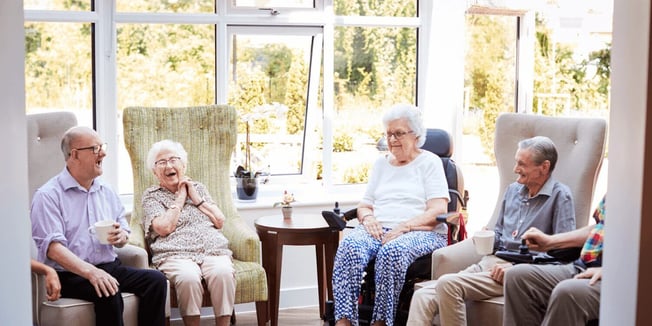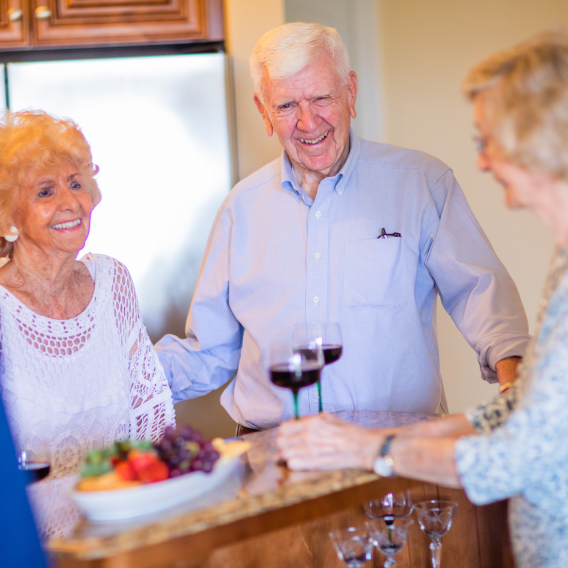Senior Living Community vs. Facility: What’s the Difference?
Listen to this article

What do you think of when you hear the phrase “senior living facility”? Does it stir up the same imagery as a “senior living community”? Although the terms are often used interchangeably, they’re actually quite different.
Most senior living communities include on-campus facilities for activities like dining and fitness, but a senior living community is so much more than its facilities. The concept of a “senior living facility” is only a portion of the dynamic resources offered at a senior living community. A senior living community is a vibrant, welcoming home where residents make new friends, create memories, and participate in engaging activities.
Let’s discuss what makes a “senior living community” different from a “senior living facility,” and how the idea of senior living has vastly evolved over time.
Today, Senior Living Culture Is All About Community
You may think that your parents are too free-spirited or perhaps too stubborn to enjoy a senior living community, but they may surprise you. Open your mind to the possibilities when it comes to the next stage in your senior parent or loved one’s life.
Moving to a senior living community is an opportunity to enhance your parents’ lifestyle, providing the support they need while they continue doing what they love—with more time to do it. Senior living offers a maintenance-free lifestyle, giving residents more time to focus on hobbies and passions, and making memories with loved ones. Many people even find new interests and pastimes when they move into senior living communities.
Naturally, different people require different kinds of care. Maybe your loved one is still completely self-reliant and just wants to let go of household chores like lawn and house care. Perhaps they are still independent but could use some help with basic daily tasks. It’s probably difficult to picture your loved one in a senior living “facility,” but knowing that they’re moving into a healthy, vibrant community instead can make the decision easier.
Today, senior living communities offer residents a lot more. They provide an easier, freer way for seniors to live their best lives. Depending on the location, they can enjoy a gorgeous campus with access to plenty of indoor and outdoor spaces for spending time with friends, attending engaging events, and meeting new people with similar interests.
What Is a Senior Living Community?
At its most basic definition, a senior living community is for seniors over 55—but it certainly doesn’t end there. People originally started calling the places where seniors received a certain level of personal and medical care “facilities'' because, back then, they were focused almost exclusively on medical and healthcare services.
Skilled Care vs. the “Community” Difference
Today, plenty of people still require a skilled nursing facility, which is a patient-focused medical environment that provides various levels of clinical care. If your loved one needs around-the-clock medical care, a skilled nursing facility may be the appropriate choice. However, a skilled nursing facility is not the same as a senior living community.
Modern senior living communities usually have various on-campus facilities available, such as medical offices or physical therapy suites, and high-quality communities should focus on care efficiencies, staff skills, and residents’ health outcomes. It’s easy to understand why people assume that all senior living takes place in a “facility,” but the essential aspect of today’s senior living is actually the word “community.”
If the focus is only on the facilities available inside of a community, you’ll never shake those old stereotypes that are no longer relevant. Senior living used to be a lot different, and it has come a long way.
Senior Living: Background
Today’s senior living communities stem from the private nursing homes of the 1950s, which were prescriptive in nature and focused on the resident only as a patient in a medical setting, not as a human in a community. This generic but widespread approach from decades ago is likely how negative pop culture imagery of senior living facilities became a pervasive idea.
Movies, books, and TV shows often portray “nursing homes” as sad, sterile, and overall unpleasant environments—but the truthful story of senior living is one of positive and progressive change. The term “senior living facility” is no longer inclusive of everything that a senior living community has to offer its residents.
Senior Living: The New Reality
Modern senior living communities are about a lot more than patient care facilities. Senior living has evolved alongside changing senior needs and senior attitudes. The term “senior living facility” simply doesn’t encompass the full spectrum of care and consideration that comes with joining a modern senior living community.
Today's aging adults have a whole new idea of what “retirement” means and what they expect out of this next phase of their lives. They’re continuing to pursue their passions, and many intend to keep working in their chosen career. They want to learn new things, explore new places, and create meaning for themselves and those around them.
As a result, senior living communities must meet new consumer expectations of the senior living lifestyle, which offers a slew of benefits for residents, including:
- Enjoying and fostering friendships, new and old
- Participating in leisure, even if leisure means a power walk
- Learning new skills, because people never stop being curious
- Finding new hobbies and enjoying old pastimes
- Hosting family and friends for holidays and other celebrations
- Enjoying all the experiences they previously didn’t have time for
- Taking advantage of amenities, like chef-styled meals
Boomers Have Changed the Senior Living Landscape
Baby boomers never saw themselves getting old, but now it’s time for them to retire, and they want to do so in their own way. Naturally, baby boomers have a completely different life than their parents did and, as a result, their retirement looks different as well.
The first thing they’re doing differently: working longer and retiring later than their parents. The Greatest and Silent Generations had less trouble admitting that they were getting older, but baby boomers don’t consider themselves “old” until they hit 75, even as they become the largest generation to ever retire in the U.S.
Boomer attitudes toward senior living are different in so many positive ways. For one, they seek an elevated experience that will support their current way of life. More specifically, they’re interested in staying active, demand up-to-date tech, and care about things like sustainable living and wellness. It’s unlikely that a traditional senior living facility focused solely on healthcare could help residents reach these goals.
Not sure which lifestyle option is right for you? We've got a quiz for that. Answer a few questions
to get direction from our experts.
Take the QuizBoomers’ High Standards Define the Future of Senior Living
These newfound boomer demands are part of why senior living communities have evolved into meaningful homes centered on connection and compassion. An ideal senior living community offers not just luxury amenities but also enriching activities and plenty of time with family and friends—all without the hassle of maintaining a household.
The future of senior living is about maintaining health, freedom, and enrichment at every age. Are medical or healthcare facilities involved? Sure, but these elements are a small part of the larger senior living community, and not representative of the environment or experience as a whole.
Taking the Next Steps with Your Senior Loved One
Understanding the differences between “community” and “facility” may sound trivial, but these differentiations are essential to paint a clear and truthful picture of modern senior living. With so much more to offer than everyday facilities, today’s senior living communities aim to satisfy all areas of life by meeting the full spectrum of social, emotional, and physical needs.
After learning about the progress made in senior living over the years, your next steps are to determine which type of senior living lifestyle your loved one intends to lead. Various levels of care exist, from independent and assisted living to personal care and memory care.
At Cedarhurst, you can rest assured that you have reliable support as you explore senior living options. We give you access to all the information and resources you need to find the right senior living community for your parent or loved one.
This post was originally published in January 2021 and updated in November 2024.






.png?width=307&height=200&name=Blog%20%2333%201400%20x%20700%20(1).png)

.png?width=307&height=200&name=Blog%20%2332%201400%20x%20700%20(8).png)



